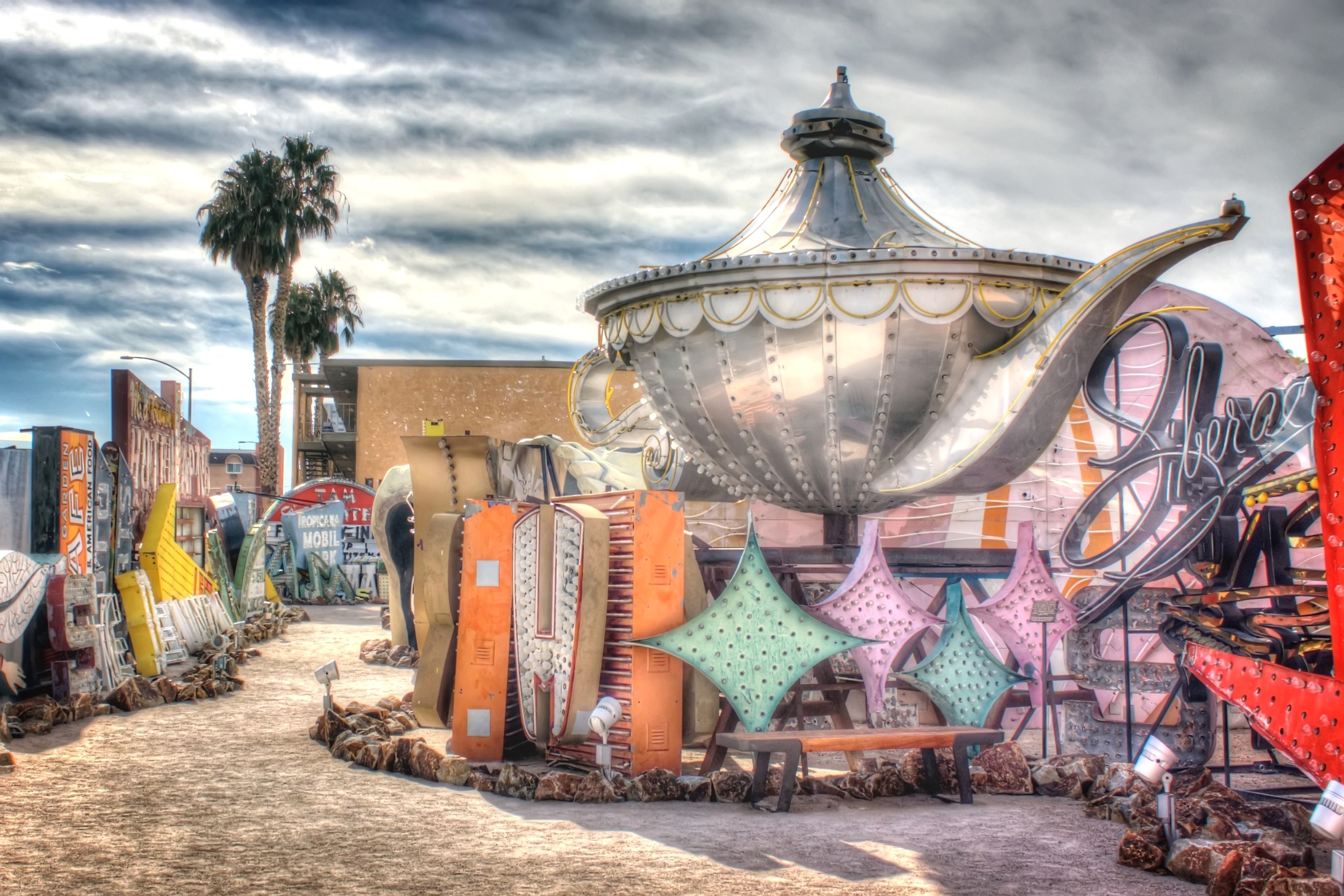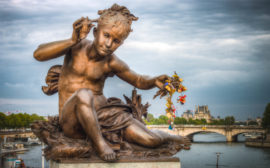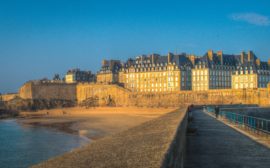When you fly into Las Vegas the “oohs” and “ahhs” can be heard as soon as the plane banks towards MacCarran, providing eager partiers and hopeful gamblers their first view of the Las Vegas Strip. If you’re flying at night, the Strip is lit up, 7 kilometres of megaresorts and entertainment venues blasting light and energy into the desert sky. The Luxor’s sky beam, the brightest light in the world at 40 billion candlepower, shines as a beacon to those seeking the sights and sounds of Sin City. And yet, from space, the beam gets lost amidst all the other lights on the Strip. That’s how many there are. It’s a city built on exterior illumination, a city known for its neon.
Thankfully, there’s an organiztion in town that honours the neon tradition. The Neon Museum on North Las Vegas Blvd, hosts almost 150 signs; they tell the Las Vegas story through design, iconic names, decaying letters, and famous logos. More than eight decades of Las Vegas history is represented here, with signs from the 1930’s through to present day.
The location is handy; it’s just a few minutes away from the Fremont Street Experience, so if you’re planning on doing Fremont, it’s easy to do both. As a history nerd and unabashed Vegas fan, I couldn’t wait to explore the Neon Museum (the fenced outside area known as the Neon Boneyard). Angela and I had spent the morning exploring Red Rocks Canyon in our trendy rented Yaris, so it was an easy drive from there. Free  parking is available right across the street from the museum. In Vegas, where nothing is free, we were thankful for it.
parking is available right across the street from the museum. In Vegas, where nothing is free, we were thankful for it.
We were early for our tour so they allowed us to join an earlier group, which was fantastic. There were about fifteen people on the tour, a group of tourists from various US cities, a couple from Europe, and we were the lone Canadians.
Taking a tour is mandatory if you want to see the grounds – no one is allowed to meander through without accompaniment. I was a little bit disapointed about this, as I love to wander through places like this at my own pace, but my fears were quickly put to rest once we started. The tour was led by an enthusiastic guide who was chock full of information. She didn’t rush, and everyone had plenty of time to take pictures, ask questions, and explore the yard. As someone who is always at the back of the pack snapping photos, I appreciated her exceptional ability to project, although I bet their neighbours are sick of hearing about Binion’s Horseshoe, the Sahara, and tales about the mob.
I, however, was not. I love tales about Binion’s Horseshoe, the Sahara, and the mob. I also really dug the way they laid everything out in the Boneyard. The signs are displayed in a way that shows them off as the pieces of fantastically kitchsy art that they are; some have said that this is the place that neon signs go to die, but I think the opposite is true. It’s the place where neon comes to be seen, admired, and brought back to life.

The Boneyard is obviously well maintained and controlled. Operated as a non-profit by people who are passionate about their role in preserving an integral part of Vegas history, the Neon Museum is a very nice facility.
Mixed in with the huge marquee signs are plenty of smaller ones, often sitting in the shadows, but they all play a role in telling the Las Vegas story.

Some in Vegas gamble for high stakes, while others gamble on cheap steaks…

One of the highlights for me was the Stardust sign, sitting in front of neon that used to hawk the Riviera and Liberace.

Caesar’s Palace has always been one of my Vegas favourites, so I was on the lookout for any and all Caesar’s artifacts…

Some of the more interesting signs are those that show some miles.

Some of the details in the signs were fascinating. This is the Steiner’s “Happy Shirt” sign, an animated sign with moving arms. Even when not lit you get a sense of the motion in this design, and the shirt does indeed look happy. He used to have a cigarette in his mouth as well, which is so “Vegas” it’s perfect.

This was one of my favourites of the day, neon reaching into the bright blue sky.

The La Concha sign is featured prominently as you enter the Boneyard, which makes sense as the main museum building and lobby area was taken – literally taken, as in, the building was moved – from La Concha’s front entrance when it was shut down. Crazy, and another little detail that makes this place both interesting and unique.

Random letters are scattered throughout the lot, meaning that people were inevitably snapping photos to piece together their names, the names of loved ones, or maybe to piece together threatening messages to neighbours who just took up practicing their tuba at three in the morning. Either way, it was fun to chase down certain letters and watch others do the same.

The main courtyard boasts some of the biggest marquee signs, the east side of the yard featuring the Sahara, Frontier, and Silver Slipper.

As you leave, perhaps to migrate south down Las Vegas Boulevard, a large duck bids you adieu. He doesn’t say anything, but I imagine that’s what he would do if he could talk. Then again, if he could talk he probably wouldn’t be in a neon boneyard – he’d be living the high life in Hollywood because, well, talking duck. But I digress. The duck is from an old auto dealership called Ugly Duckling Car Sales, and is a crowd favourite here in the Boneyard.

We enjoyed everything at the Neon Museum, from the tour guide to the well-defined pathways. Now that I’ve done this tour in the day, I would love to come back at night and check out some of the signs in their lit-up state (they don’t light everything in the lot, but do light up seven of the more prominent signs in the Boneyard).
Following our time at the Neon Museum we zipped down the street to the Fremont Street Experience where we went on a quest for the perfect hot dog. FIlled with neon dreams and questionable street food, we slept well after a perfect day in Vegas.
Have you been to the Boneyard? What did you think? Any other comments? Please feel free to share in the space below, and thanks for reading! Cheers –




